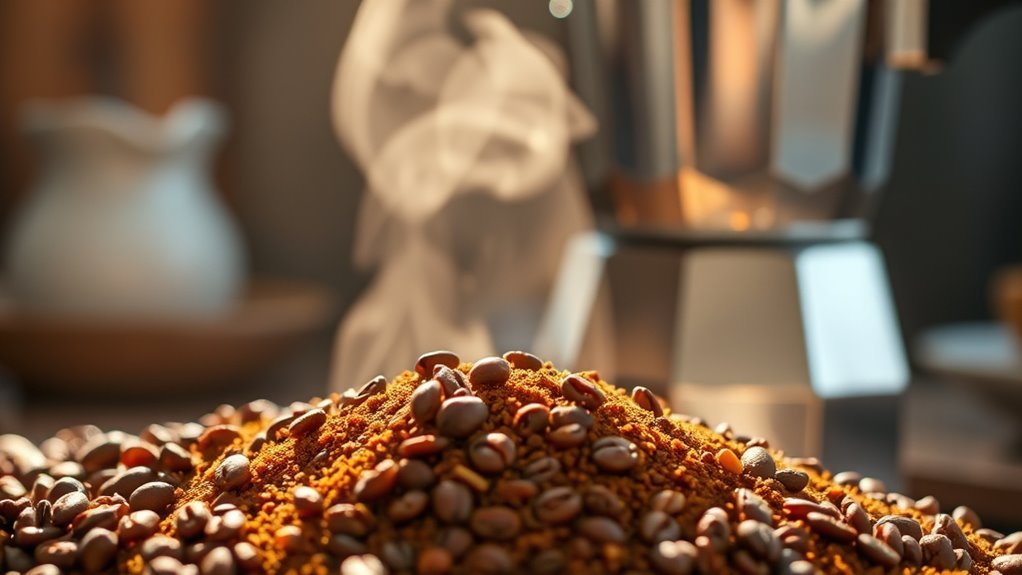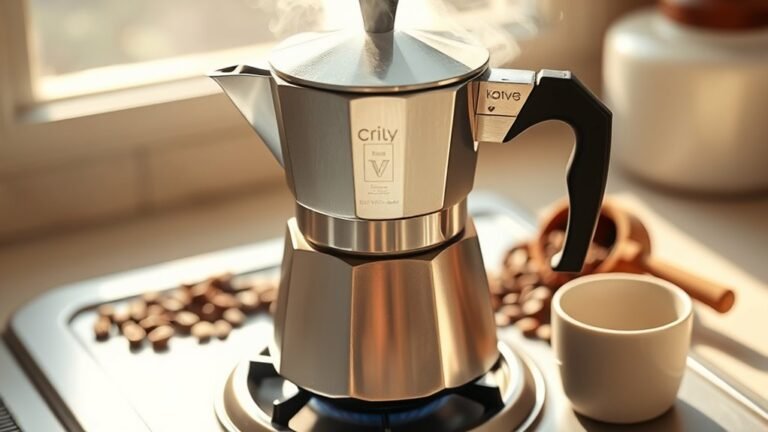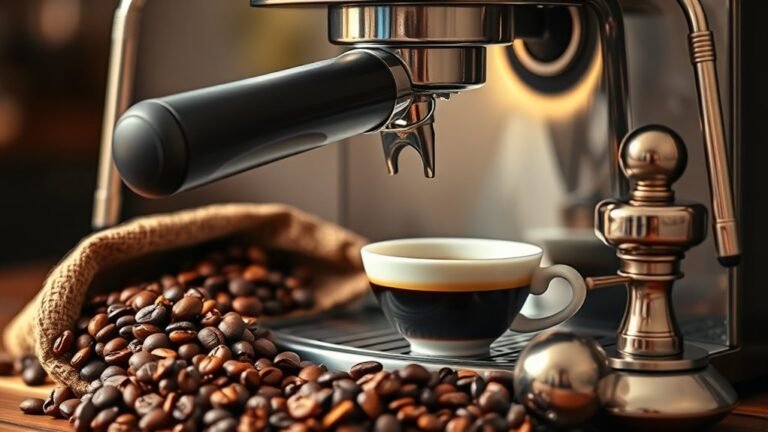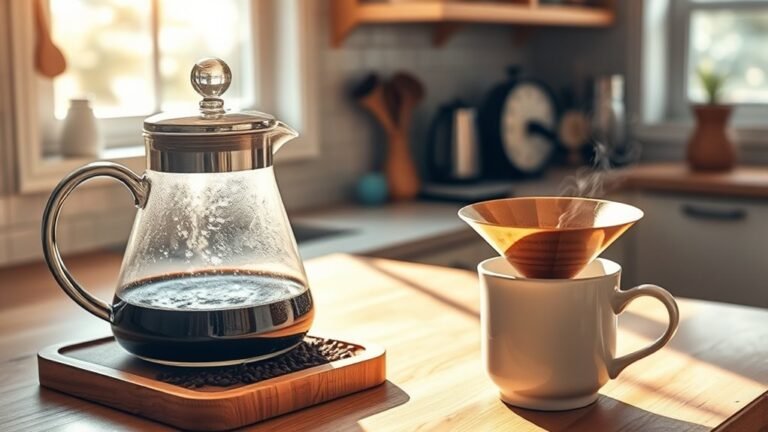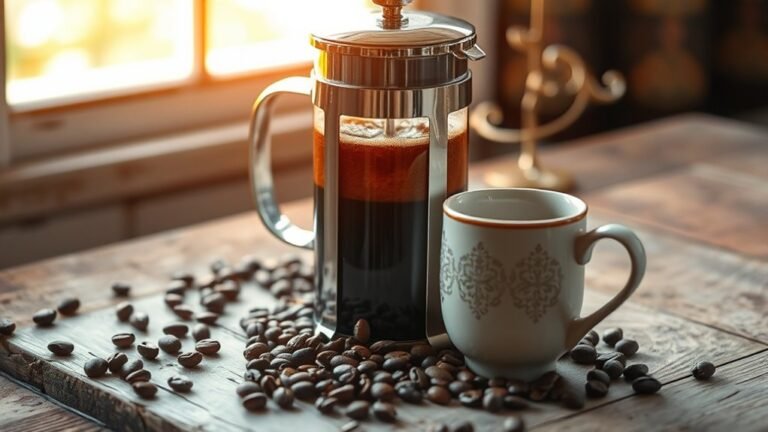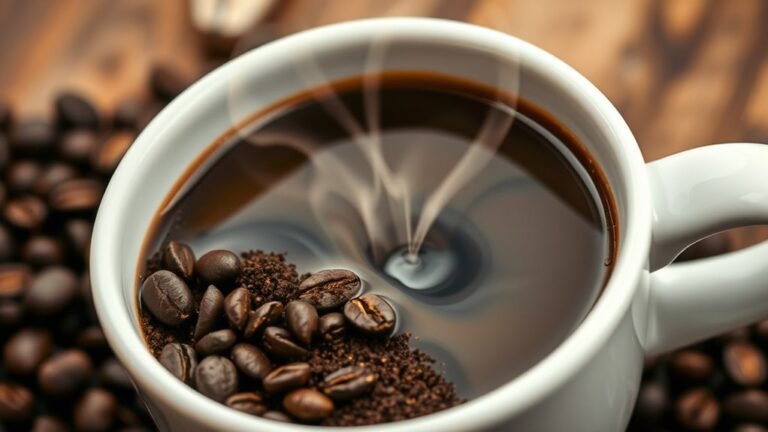The Best Coffee for a Percolator
For the best percolator coffee, choose freshly roasted beans, ideally medium roast to balance acidity and body without bitterness. Use a medium-coarse grind to guarantee consistent extraction during the brewing cycle. Weigh about 15-18 grams of coffee per 250 ml of water for precise strength. Avoid overly dark roasts since prolonged heating can cause harsh flavors. Proper freshness and grind size are key for ideal flavor control. There’s more to mastering your percolator beyond these essentials.
Understanding How a Percolator Works
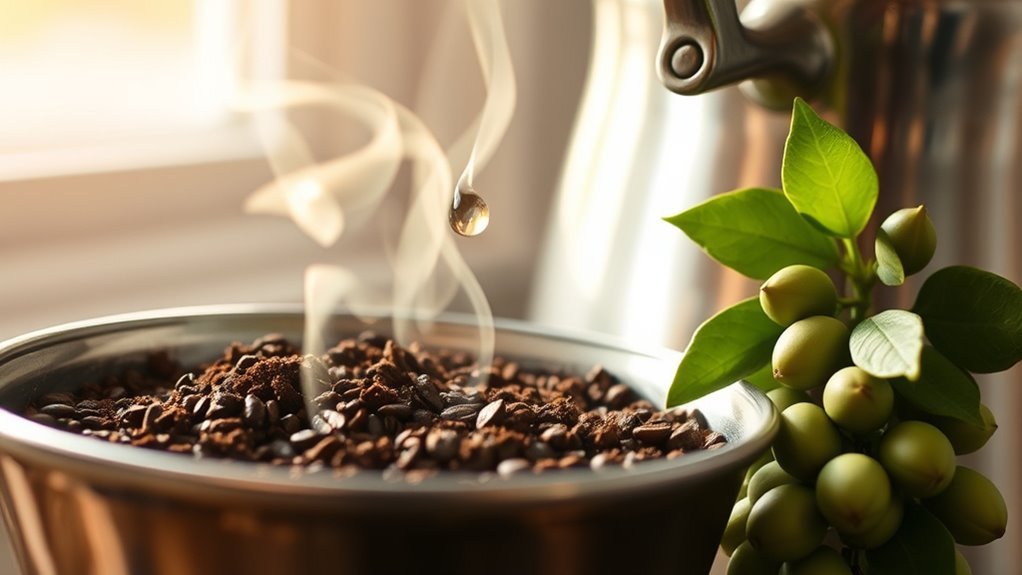
A percolator operates by cycling boiling water through coffee grounds repeatedly until the desired strength is achieved. You’ll find that the percolator mechanics rely on a heat source pushing water upward through a central tube. This water then disperses over the coffee grounds housed in a perforated basket. As gravity pulls the water back down, it extracts coffee solubles, intensifying flavor. The brewing process is continuous, with water repeatedly passing through the grounds, allowing you control over strength by timing the cycle. Understanding this mechanism means you can tailor your brew without additives, embracing freedom in your coffee experience. Precision in heat and timing guarantees ideal extraction, preventing over-extraction bitterness or under-extraction weakness, giving you mastery over your percolated coffee.
Importance of Coffee Bean Freshness
Freshness greatly impacts the quality and flavor profile of coffee brewed in a percolator. When selecting beans, you must consider key freshness factors such as roast date, oxygen exposure, and moisture content. Oxidation degrades aromatic compounds, diminishing the vibrant flavors percolators extract. To preserve freshness, adopt airtight storage methods—vacuum-sealed containers or one-way valve bags—to minimize oxygen and humidity infiltration. Avoid transparent containers that expose beans to UV light, which accelerates staling. Also, keep beans away from heat sources and fluctuating temperatures, as thermal stress hastens degradation. By maintaining ideal freshness through precise storage, you empower yourself to unleash the full potential of your percolator’s extraction process. This technical control over freshness guarantees a more balanced, nuanced cup, allowing you freedom to enjoy coffee at its peak.
Ideal Coffee Bean Roast Levels for Percolators
Choosing the right roast level is essential for optimizing extraction in your percolator, as different roasts respond uniquely to its brewing dynamics. Light roast beans retain more acidity and complex flavor compounds but can under-extract if overpowered by the percolator’s high temperature. Dark roast beans, conversely, offer bolder, smokier notes and extract more quickly, but risk bitterness with prolonged brewing. To strike the perfect balance, consider these points:
- Light roast provides nuanced flavors but demands careful timing.
- Dark roast suits percolators’ robust heat cycles.
- Medium roasts offer a compromise, balancing acidity and body.
- Avoid ultra-dark roasts to prevent excessive bitterness.
- Experiment with blends to tailor strength and flavor depth.
Optimal Grind Size for Percolator Brewing
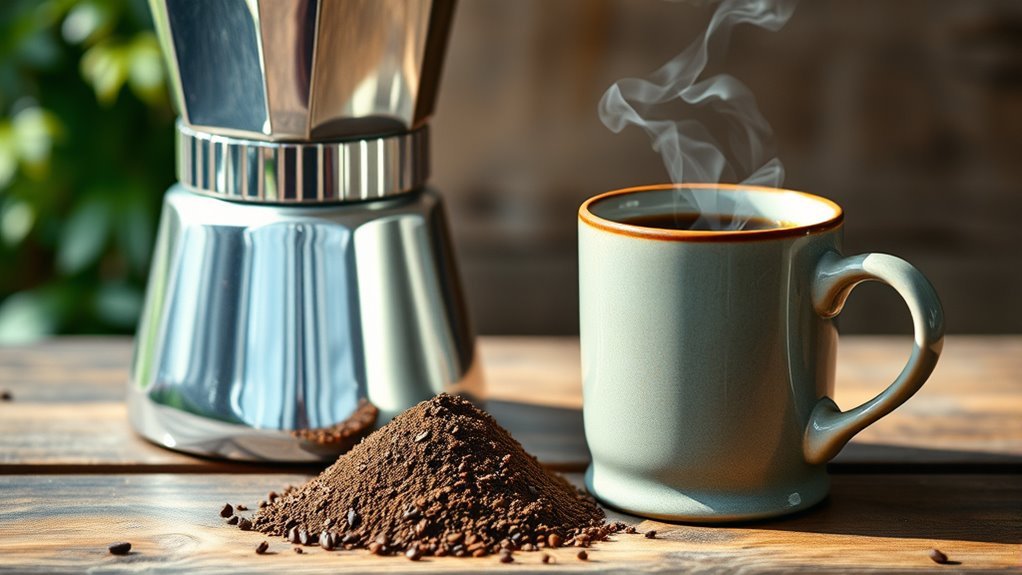
Although percolators are versatile, the grind size you use plays an essential role in achieving ideal extraction and avoiding over-extraction or clogging. For percolator brewing, a medium-coarse grind is optimal, balancing extraction rate and preventing grounds from slipping through the basket. Consistent grind size guarantees uniform water flow and stable brewing time, typically between 7 to 10 minutes, critical for flavor clarity without bitterness. Too fine a grind increases surface area, accelerating extraction and risking bitter notes, while too coarse results in under-extracted, weak coffee. Maintaining grind consistency is necessary to control brewing dynamics, allowing you to fine-tune strength and flavor profile. By mastering grind size precision, you gain full control over your percolator’s performance, crafting coffee that matches your freedom to brew exactly how you like.
Single-Origin vs. Blended Coffee Beans
How do single-origin and blended coffee beans influence the flavor profile when brewing with a percolator? Single origin benefits include distinct, traceable flavors from specific regions, offering clarity and complexity in your cup. Blended versatility, on the other hand, balances multiple beans to create consistent, harmonious profiles adaptable to percolator extraction nuances.
Single-origin beans offer distinct clarity, while blends provide balanced, consistent profiles perfect for percolator brewing.
Consider these factors when choosing:
- Single-origin beans reveal unique regional notes but can be more sensitive to brewing variables.
- Blends provide balanced acidity, body, and aroma, adapting well to percolator’s cyclical extraction.
- Percolators accentuate boldness; single origins may highlight brighter, sharper tones.
- Blended coffees reduce the risk of over-extraction bitterness through flavor harmonization.
- Your freedom to experiment with single origins or blends lets you tailor flavor intensity precisely.
Choose based on your preference for clarity or consistent complexity in your percolated brew.
How Water Temperature Influences Extraction
Water temperature plays a critical role in extracting the best flavors from coffee grounds in a percolator. If your water temperature is too low, extraction efficiency drops, resulting in under-extracted coffee with sour or weak notes. Conversely, excessively high temperatures can cause over-extraction, pulling out bitter compounds and diminishing balance. Ideal water temperature for percolator brewing generally ranges between 195°F and 205°F (90°C to 96°C). Within this range, extraction efficiency maximizes, allowing soluble coffee compounds to dissolve effectively without degrading delicate aromatics. Since percolators continuously cycle heated water over grounds, maintaining consistent temperature is essential for achieving a clean, robust cup. By controlling water temperature precisely, you gain freedom to highlight your coffee’s nuanced flavors, ensuring every brew reflects your preferred strength and complexity.
Popular Coffee Varieties for Percolator Use
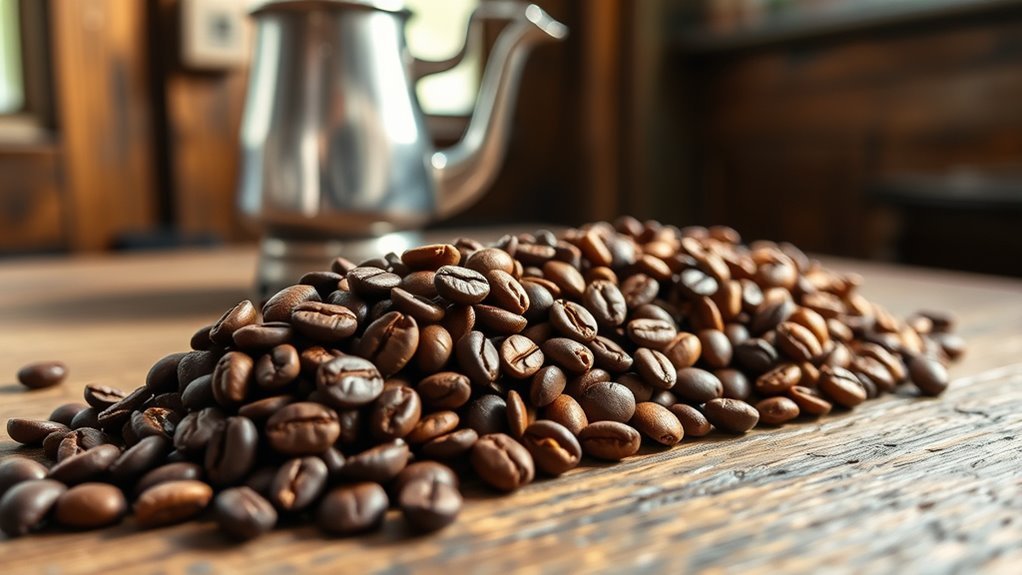
When selecting coffee for your percolator, you’ll want varieties that can withstand the unique brewing process without losing their essential characteristics. Percolators expose coffee grounds to repeated hot water cycles, demanding resilient coffee types with robust flavor profiles. Here are popular choices:
- Arabica: Known for a balanced acidity and complex flavor, it maintains clarity despite high heat.
- Robusta: Offers a stronger, more bitter profile with higher caffeine, standing up well to percolator intensity.
- Sumatra: Earthy, full-bodied, and less acidic, ideal for rich, bold extraction.
- French Roast: Dark roast with smoky notes, its oils survive the percolator’s cycle.
- Espresso Blends: Typically robust and concentrated, these blends hold up well, delivering intense flavor.
Choosing the right coffee type guarantees your percolator brew is both flavorful and true to the beans’ profile.
Tips for Measuring Coffee to Water Ratio
Achieving the ideal coffee to water ratio is essential for extracting balanced flavors with your percolator. Start by using precise coffee measurement techniques: weigh your coffee grounds instead of relying on volume, as density varies. A standard ratio is 1 to 1.5 tablespoons of coffee per 6 ounces of water, but weighing 15-18 grams of coffee per 250 ml of water guarantees accuracy. Consistency is key—use a digital scale to replicate this ratio every time, improving brewing consistency. Also, verify your water measurement is exact; small deviations can alter extraction and flavor. By mastering these measurement tips, you gain control over strength and taste, allowing you to enjoy your coffee freely without compromising quality.
Common Mistakes to Avoid When Using a Percolator
One of the most common errors you’ll encounter with a percolator is using coffee grounds that are too fine, which can lead to over-extraction and a bitter taste. To maximize your freedom in brewing, avoid these common mistakes in percolator usage:
- Using overly fine grounds instead of coarse ones designed for percolators
- Filling the basket too full, which restricts water flow and causes uneven extraction
- Boiling the water too vigorously, leading to harsh flavors and potential scorching
- Ignoring the proper coffee-to-water ratio, resulting in weak or overpowering coffee
- Skipping regular cleaning, which allows residue buildup and impairs taste
Enhancing Flavor With Coffee Additives and Enhancers
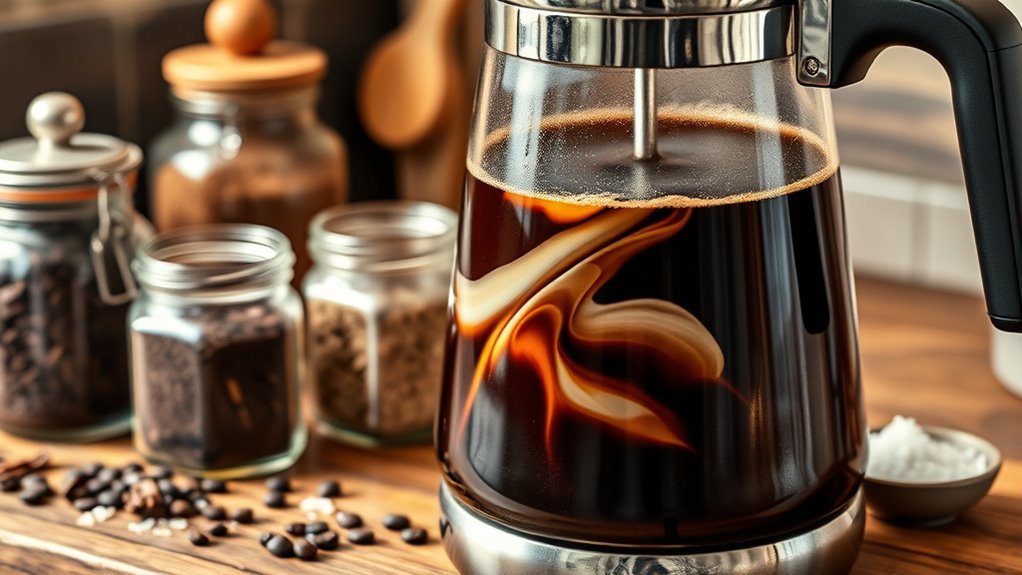
Although percolators extract coffee differently than drip machines, you can still tailor your brew’s flavor profile by carefully selecting additives and enhancers. Spice additions like cinnamon or cardamom enhance warmth, while nut extracts provide subtle complexity. Sweetener options vary from natural honey to artificial sweeteners, each impacting mouthfeel uniquely. Milk alternatives such as oat or almond milk adjust creaminess without overpowering. Flavor syrups and cream enhancements allow precise sweetness and texture control. Chocolate infusions add depth, and herbal infusions introduce invigorating notes.
| Additive Type | Examples | Flavor Impact |
|---|---|---|
| Spice Additions | Cinnamon, Cardamom | Warmth, aromatic depth |
| Sweetener Options | Honey, Stevia | Sweetness, mouthfeel |
| Milk Alternatives | Oat, Almond Milk | Creaminess, lightness |
| Flavor Syrups | Vanilla, Hazelnut | Sweetness, flavor complexity |
| Herbal Infusions | Mint, Lavender | Freshness, subtle aroma |
Frequently Asked Questions
Can I Use Flavored Coffee Beans in a Percolator?
You can use flavored coffee in a percolator, but keep in mind that brewing techniques specific to percolators might amplify the flavor intensity. Since percolators cycle boiling water through grounds repeatedly, flavored coffee can become overpowering or bitter if over-extracted. To maintain balance, use coarsely ground beans and monitor brewing time closely. This approach lets you enjoy flavored coffee while preserving nuanced tastes, giving you freedom to experiment without sacrificing quality.
How Do I Clean My Percolator After Brewing?
Ever wondered why your percolator’s taste fades over time? Proper cleaning techniques are key. After brewing, disassemble all parts and rinse with warm water. For stubborn stains, soak in a vinegar-water solution (1:1) for 30 minutes, then scrub gently. Maintenance tips include drying thoroughly to prevent rust and mineral buildup. Regular cleaning guarantees freedom to enjoy fresh, pure coffee flavor every time without compromise.
Is It Better to Use Bottled or Tap Water in a Percolator?
When brewing with a percolator, water quality greatly impacts flavor extraction and brewing temperature stability. Using bottled water often guarantees consistent mineral content, preventing scale buildup and maintaining ideal brewing temperature. Tap water varies widely in hardness and impurities, which can alter taste and damage your percolator over time. For precise control and freedom from unwanted flavors, you’ll likely prefer bottled water, especially if your tap water’s quality is questionable or heavily chlorinated.
How Long Does Percolator Coffee Stay Fresh After Brewing?
You’ll find that percolator coffee freshness lasts best when consumed within 30 minutes post-brewing. After that, brewed storage in an insulated container can extend freshness up to 2 hours, though flavor and aroma gradually degrade. Avoid leaving coffee on a heat source, as prolonged heat accelerates staling and bitterness. For ideal taste freedom, transfer brewed coffee promptly to a thermal carafe, preserving its nuanced profile without sacrificing quality.
Can I Use Decaffeinated Coffee in a Percolator?
You can definitely use decaffeinated coffee in a percolator, but keep in mind decaf brewing often results in a slightly different extraction profile. Because decaf beans tend to be less dense, you might notice a milder coffee strength compared to regular blends. Adjust your grind size and brewing time accordingly to optimize flavor. Experimenting gives you the freedom to dial in the perfect cup, ensuring your decaf percolator brew meets your taste preferences precisely.
